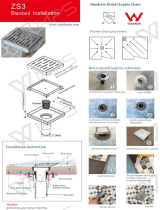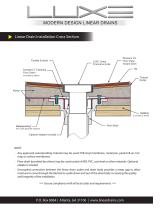Page is loading ...

ACO Bathroom Drainage
Linear shower drains
Installation Guide

www.QuARTzbyACO.com
2
Technical & planning considerations
Accumulation and slopes
ASME A112.6.3-2001 requires a 2“ outlet
for shower applications. QuARTz by ACO
channels have this as standard. The flow
value for a 2" outlet varies depending upon
the head of water above the grating.
In the case of shower channels, a head
of water is not typical in practice, due to
shallower floor grades. Floor drains can
have a head of water due to ‘basin’ profile
of floor grades.
Flow values without any accumulation (head
of water) should be used when shower
channels are placed around the perimeter
of the shower and no shower threshold step
is used.
If the shower channel is installed against
a wall, there may be a small amount of
accumulation (head of water) depending
on the layout of the shower area. Grade
of shower floor will determine depth of
build-up.
Installation against the wall.
Outlet flow rate up to 9.51 GPM based on floor
grades such that 0.2” (5 mm) head of water
possible.
Installation at the entrance
Outlet flow rate up to 6.65 GPM based on no
water accumulation (head of water).
Outflow performance
The choice of shower channel generally
depends on the flow values of the shower
fitting. 70 % of shower heads have a
maximum capacity of less than 3 GPM.
The QuARTz by ACO shower drain standard
channel has an outflow of 6.65 GPM. This
value assumes no head of water above
drain.
Based upon these flow rates the QuARTz
by ACO shower drain standard channel can
be used in conjunction with the majority of
shower head fittings.
A number of custom solutions are available
to cope with shower heads with higher flow
rates (see page 12).
Outlet flow rates (GPM)
Accumulation (head of water)
Grate 0“ (0mm) 0.2“ (5mm) 0.6“ (15mm)
Channel body only
6.65 9.51 11.60
Note: Based on 900mm shower drain with standard 2” outlet
Effect of grate on outlet flow rates (GPM)
Accumulation (head of water)
Grate 0“ (0mm) 0.2“ (5mm) 0.6“ (15mm)
Tile
6.49 9.28 11.32
Quadrato
6.34 9.07 11.06
Flag
6.34 9.07 11.06
Wave
6.00 8.58 10.47
The addition of a grate will throttle the intake
of water into the channel body and slow the
flow of water to the outlet.

3
Linear drainage options
Installation against the wall Walk-through: Installation against the wall Walk-in: Installation against the wall
Simplest slope solution in one direction – slope
away from the bathroom – no risk of bypass –
use of CPE flexible membrane is recommended.
Slope in one direction – just shower area or
whole bathroom floor can be sloped towards
channel – use of CPE flexible membrane is
recommended.
Simplest slope solution in one direction –
slope away from the bathroom – no risk
of overshooting water – use CPE flexible
membrane is recommended.
Installation at shower entrance Walk-through: Installation with two channels Walk-in: Installation at the entrance
Slope in one direction, towards the bathroom –
possible risk of bypass – slope of bathroom
floor towards shower area is recommended to
prevent bypass. Channel length should exactly
fit the shower opening.
Two directional slope towards the bathroom.
Channel length should exactly fit the shower
opening.
Two directional slope towards the channel.
Channel length should exactly fit the shower
opening.
Drainage planning information

www.QuARTzbyACO.com
4
1. Where alterations to floor joists are
necessary consult Structural Engineer for
advice and reinforce floor joists as advised.
2. Frame out shower surround as required.
3. Connect base of flange outlet adaptor to
pipe work, leaving drain bolts in place. Block
drain opening with rag to prevent floor mortar
blocking pipe work.
4. Trowel mortar onto sub-floor.
5. Install CPE membrane, reinforce around
outlet and cut carefully to reveal heads of
drain bolts and outlet.
6. Install top section of flange outlet adaptor.
7. Test membrane for leaks
8. Lubricate outlet spigot on shower channel
(liquid soap) and push fit shower channel into
correct position and height.
9. Cut plastic installation feet to height to rest
on the membrane and keep shower channel
at required height and level.
10. Trowel mortar to required height, allowing
for thickness of tile and thin set mortar and
grade to create 1% slope towards the drain.
11. After floor mortar has cured, apply thin set,
install tile and grout.
12. Install grate into shower channel.
Installation overview
Tiled showers rely on waterproofing
membrane beneath the tiles and grout.
QuARTz by ACO offers a number of options
to ensure compatibility with different floor
structures.
The installation details shown set out
to provide the designer with integrated
solutions to wet room floor drainage
identifying preparation, installation and
construction processes required to install
waterproof channels and floor gullies in
level threshold wet room environments.
Although these details do not cover
every possible situation, they do provide
a practical reference to most design
applications.
Plain body - joisted wooden floor
G
G
G

5
Flange body - concrete floor
Showerchannel length(l)
plus 2” (50mm)
Max width
12” (300mm)
Width at end
9” (225mm)
Showerchannel length(l)
plus 2” (50mm)
Max width
12” (300mm)
Width at end
9” (225mm)
Showerchannel length(l)
plus 2” (50mm)
Max width
12” (300mm)
Width at end
9” (225mm)
1.
2.
3.
Box out detail showing suggested
dimensions
After removing box form work
connect shower channel to plumbing
pipe work using stainless steel
connector part number 93874.
Shower channel fitted in place prior
to final concrete slurry pour. Shower
channel flange should be at same
level as original concrete slab.
G
G
1. Frame out shower surround in concrete slab
as required, see diagram top right.
2. Set top edge of shower channel slightly
below finished tile level, cut plastic installation
feet to height to hold shower channel at
required height and level.
3. Connect outlet to pipe work using 2“
stainless coupler.
4. Pour concrete slurry into framed out
void in concrete slab to height of flange on
channel body.
5. Install ‘hot-mop’/liquid membrane, fully
covering concrete and flange of shower
channel in accordance with manufacturer‘s
instructions.
6. Trowel mortar to required height and grade,
approx. 1%.
7. Apply thin set.
8. Lay tile and grout.
9. Install grate into shower channel.
G

© July 2011 ACO Polymer Products, Inc.
All reasonable care has been taken in compiling the information in this document. All recommendations and suggestions on the use of ACO products are made without
guarantee since the conditions of use are beyond the control of the Company. It is the customer’s responsibility to ensure that each product is fit for its intended
purpose and that the actual conditions of use are suitable. ACO Polymer Products, Inc. reserves the right to change products and specifications without notice.
East Sales Office
P.O. Box 245
Chardon, OH 44024
Tel: (440) 285-7000
Toll free: (800) 543-4764
Fax: (440) 285-7005
West Sales Office
P.O. Box 12067
Casa Grande, AZ 85130
Tel: (520) 421-9988
Toll Free: (888) 490-9552
Fax: (520) 421-9899
Electronic Contact:
www.QuARTzbyACO.com
ACO Polymer Products, Inc.
Other ACO product lines
ACO DRAIN
ACO Drain is the world's leading modular trench
drain system for commercial, industrial and
landscape applications.
ACO SPORT
ACO Sport is a range of surface drainage and building
accessories for track & field, used at Olympic sites
since 1972.
AQUADUCT
Aquaduct custom designs and manufactures
fiberglass trench drain systems to meet individual
project requirements.
ACO ROAD
ACO Road is a range of surface drainage products
engineered for the unique design and performance
demands of highways, urban roads and bridges.
MARKANT BY ACO
Markant by ACO is a range of building products
designed for the residential builder and DIY
enthusiast.
ACO WILDLIFE
ACO Wildlife is a tunnel and fence system designed
to guide amphibians and other small creatures
safely across roads.
QuARTz by ACO is a division of ACO Polymer Products, Inc.
Follow us on
/







